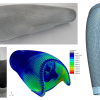3D printing of prosthetic devices
Technology description
| The name of the technology: | 3D printing of prosthetic devices |
|---|---|
| Challenge: |
The motivation for the use of additive technologies in the production of prosthetic aids is a significant shortening of the production of prosthetic aids, a reduction in production costs, digitization of the design process with the possibility of using parametric models. The possibility of producing multiple prostheses at one time is guaranteed by the use of 3D printing, where multiple prostheses can be printed at once during production. During the design, it is possible to use the support of CAE programs and perform strength and stiffness analyzes before production itself. Prostheses are made of thermoplastic, which, thanks to its recyclability, is a lower burden on the living environment compared to commonly used composite materials. |
| Description: |
The technology of producing a 3d printed prosthesis consists of the following sub-steps: First, a plaster model of the stump is created. Subsequently, a 3D scanning method is used to digitize the shape of the stump as in data levels for CAE programs, or direct scanning is possible in suitable patients. The geometry obtained by scanning is suitably adjusted in the CAE program and the inner surface of the prosthesis is created on its basis. As part of the modifications, it is possible to apply an interface to the CAD model for future peripherals, for example for myoelectric prostheses. As part of the modeling, it is possible to apply various design structures and thereby increase the attractiveness and individuality of the newly emerging prosthesis. The last step is production using the 3D printing method. A printing method without supports is used for printing, which means that the prosthesis is ready for use immediately after printing. The novelty of this technology lies in its practical application. At present, arm prostheses are produced worldwide mainly in laminate form and by hand. This means that the prosthetist works individually with the patient and, based on manual measurements, produces the prosthesis in a conventional way. In the current procedure, 3D scanners are not used, 3D printing technology is not used, and no specific design is applied. The technological procedure we have developed therefore corresponds to prototype production, which is not yet established in prosthetic practice, but everything is moving towards it in the future. However, its deployment is also linked to the adjustment of legislation, since prostheses are a medical device and are subject to a specific regime. |
| Commercial opportunity: |
The prosthesis production technology is intended for manufacturers of prosthetic aids as an alternative to currently used laminated prostheses. |
| IP protection status: | Technologie není nijak chráněna. |
| Development status: |
Phase 2Corresponds with TRL 3 and TRL 4 Feasibility study. There is a realistic design of the technology and the initial tests in the laboratory are leading to the specification of the technology requirements and its capabilities.
|
| Partnering strategy: | Collaboration |
| More information: | |
| Images: | |
| Categories: | Mechanical Engineering |
| Institution: | University of West Bohemia |
| Owner of a technology: | Západočeská univerzita v Plzni |
